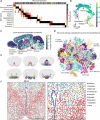Single-cell and spatial omics: exploring hypothalamic heterogeneity
- PMID: 38993130
- PMCID: PMC11688568
- DOI: 10.4103/NRR.NRR-D-24-00231
Single-cell and spatial omics: exploring hypothalamic heterogeneity
Abstract
Elucidating the complex dynamic cellular organization in the hypothalamus is critical for understanding its role in coordinating fundamental body functions. Over the past decade, single-cell and spatial omics technologies have significantly evolved, overcoming initial technical challenges in capturing and analyzing individual cells. These high-throughput omics technologies now offer a remarkable opportunity to comprehend the complex spatiotemporal patterns of transcriptional diversity and cell-type characteristics across the entire hypothalamus. Current single-cell and single-nucleus RNA sequencing methods comprehensively quantify gene expression by exploring distinct phenotypes across various subregions of the hypothalamus. However, single-cell/single-nucleus RNA sequencing requires isolating the cell/nuclei from the tissue, potentially resulting in the loss of spatial information concerning neuronal networks. Spatial transcriptomics methods, by bypassing the cell dissociation, can elucidate the intricate spatial organization of neural networks through their imaging and sequencing technologies. In this review, we highlight the applicative value of single-cell and spatial transcriptomics in exploring the complex molecular-genetic diversity of hypothalamic cell types, driven by recent high-throughput achievements.
Copyright © 2025 Copyright: © 2025 Neural Regeneration Research.
Conflict of interest statement
Figures






Similar articles
-
Single-cell sequencing to multi-omics: technologies and applications.Biomark Res. 2024 Sep 27;12(1):110. doi: 10.1186/s40364-024-00643-4. Biomark Res. 2024. PMID: 39334490 Free PMC article. Review.
-
Computational solutions for spatial transcriptomics.Comput Struct Biotechnol J. 2022 Sep 1;20:4870-4884. doi: 10.1016/j.csbj.2022.08.043. eCollection 2022. Comput Struct Biotechnol J. 2022. PMID: 36147664 Free PMC article. Review.
-
Spatial transcriptomics in development and disease.Mol Biomed. 2023 Oct 9;4(1):32. doi: 10.1186/s43556-023-00144-0. Mol Biomed. 2023. PMID: 37806992 Free PMC article. Review.
-
Dissecting mammalian reproduction with spatial transcriptomics.Hum Reprod Update. 2023 Nov 2;29(6):794-810. doi: 10.1093/humupd/dmad017. Hum Reprod Update. 2023. PMID: 37353907 Free PMC article. Review.
-
Advances in Microfluidic Single-Cell RNA Sequencing and Spatial Transcriptomics.Micromachines (Basel). 2025 Apr 2;16(4):426. doi: 10.3390/mi16040426. Micromachines (Basel). 2025. PMID: 40283301 Free PMC article. Review.
References
-
- Alvarez-Bolado G. Development of neuroendocrine neurons in the mammalian hypothalamus. Cell Tissue Res. 2019;375:23–39. - PubMed
LinkOut - more resources
Full Text Sources
Miscellaneous

